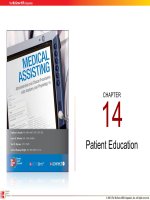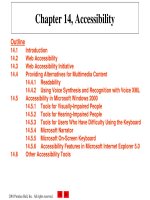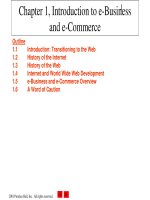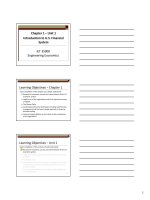Lecture Communication research: Asking questions, finding answers (4e) Chapter 14: Introduction to qualitative research
Bạn đang xem bản rút gọn của tài liệu. Xem và tải ngay bản đầy đủ của tài liệu tại đây (13.16 MB, 13 trang )
Chapter 14
INTRODUCTION TO
QUALITATIVE RESEARCH
VAR
JUA
h
n
lều
hHHCF
ap
* Preserves the form and content of interaction
* Contextually situated
* Discourse Is the data
* Analyzed for its qualities - empirical, inductive, and
interpretive
* Aims for subjectivity
* Allows interactants’ voices to be heard
* Intersubjectivity
+ The social accomplishment of how people coconstruct and co-experience their social life and
rules for doing so
* How do people understand and interpret
communication processes?
* How is communication socially situated’?
MUTUAL SIMULTANEOUS SHAPING
* The here and now
* Everything influences
everything else
* Emphasis on process
and the holistic frame of
Interaction
* Plausible explanations
built on what is
observed
ducfoñ o + cistibuli rt
_ the prior written nsent of
~~
MeGr eee one atio
INC
ANA
* From the specific to the general
* Explanations and theories emerge from the
data
* Propositions formulated continuously
throughout the data collection and data
analysis process
AOL
-
JR
7
Purpose
 Phenonfenon
Interdependent stages
Not linear
* Cannotbe plannedin
entirety
ARCH
ơ
QUALITA
ae
d
\
\
f
|
-
* Bottom reflects
activities in the field
——
—
/
j
si
of
Select data _
~~collection™
“ing Ƒ ¬
'
¬
analyse
Analysis
——
P|
\
“S|
design of the project
ie
uestions
existing
literature
N
* Top circle reflects
®
Reorerch
—
J
ee
ee
Sm-=_ —Hm=m= Kmmmm Kmm==m Jmmm cm
mm
3+FDIE
YIN
QUA
ñ
* Extent to which data interpretations are
7 true
+ correct
+ dependable
* Allows for multiple interpretations by asking
“What's plausible?”
NAAN
\
* Triangulation: use of several kinds of methods or data
to enhance credibility
+ Data triangulation
+ Investigator triangulation
+ Interdisciplinary triangulation
* Member validation
+ Taking research findings back to individuals who provided
data
CONCEPTUALIZING RESEARCH QUESTIONS
FOR QUALITATIVE RESEARCH
* Based on previous literature
* Broadly stated
* Nondirectional
* Gives researcher latitude in following interesting paths
* Specific to the interaction context
ASSESSING QUALITATIVE RESEARCH QUESTIONS
* Should ask how or
what’?
* Should reference the
research
site?
|
*
Focus ona specific type of
TR HE
* Discover how meaning is
developed/shared?
* Reveal naturally occurring
communication not suitable for
Study in an experiment?
*
Reveal unanticipated
ophenomena/influences?
*
Reveal process that occur over
time’?
* Explore the influences of the
<
* Anything that can be observed or captured
* Interpreting meaning
+ Researcher construction
+ Subjective valuing
+ Contingent accuracy
* Level of evidence
+ Microlevel, midlevel, macrolevel
ADVANTAGES
* Documents the unseen
* Provides information
about those who cannot
or will not speak for
themselves
* Supplements
information from
quantitative studies
LIMITATIONS
* Communication
environment must be
accessible
* Interactants may change
their behavior
* Observations filtered
through the researcher
* Time consuming
THREATS
TO CREDIBILITY
* Inaccuracy or incompleteness of data
* Problems of interpretation
+ Whose interpretation is being imposed’?
* Theoretical validity
+ What about data that fail to fit the interpretation?
* Selection bias
* Reactivity bias









